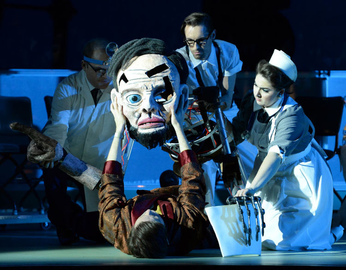The Perfect American
Puppet Designer, Video Designer, Puppet Director
Chicago Opera Theater • 2017 • Chicago, IL
U.S. Premiere - A hallucinatory look at the final days of Walt Disney, this contemporary opera by Phillip Glass, fused shadow play, puppetry, and live video to explore legacy, obsession, and the blurry line between man and myth.


REVIEWS
“Most noteworthy was the use of projections and puppets. The projections fill the world of Disney’s psyche with a strong sense of nostalgia and support the pathos Glass develops for Disney. The puppet of late President Lincoln, designed by Sean Cawelti, works incredibly well on two levels: not only is it perfect inhabitant in the imagination of Disney, but it also adds to the overall subtly eerie tone of the opera. The Lincoln scene is easily the spectacle highlight of the opera.” - Chicago Critic
"Flashbacks are in Walt’s mind. Want a train? Push a couple of beds together. Want an animatronic Lincoln? Put together a puppet in the next bed.” - Los Angeles Times
“Adding appeal are appearances by Andy Warhol and Abraham Lincoln, who returns in the suggested form of a yet-to-be-completed animatronic figure (realized here by puppet designer Sean Cawelti).” - Chicago on the Aisle
“Though there are projections (video by Sean Cawelti), the set, by Zane Pihlstrom, is made up of objects historically accurate to a 1966 hospital.” - Picture This Post
The Perfect American is Philip Glass’s kaleidoscopic opera exploring the final months of Walt Disney’s life—blurring memory, fantasy, and cultural mythology. For Chicago Opera Theater’s production, Sean Cawelti created an integrated visual design that merged puppetry, shadow imagery, and video to deepen the psychological layers of the story and reflect the fractured mind of a man confronting mortality and mythmaking.
Cawelti’s role included directing all projections, designing and building puppets, and crafting a visual system capable of fluidly shifting between realism and abstraction. Inspired by both Disney’s iconography and the darker, lesser-known aspects of his legacy, the design conjured a dreamlike world where childhood nostalgia collided with existential dread.
One of the production’s most striking moments featured a 10-foot-tall Abraham Lincoln puppet, inspired by early animatronics, wax museum figures, and prosthetic limb mechanics. Operated by a team of four puppeteers, the figure referenced Disney’s original animatronic Lincoln created for the 1964–1965 New York World’s Fair—blending historical homage with eerie theatricality.
In the opera’s emotional finale, objects from the hospital room in which Walt Disney passed away were lovingly placed one by one onto the bed, stacked into a sculptural form. A hospital light was then wheeled in front of the sculpture and aimed precisely so its shadow cast the unmistakable silhouette of Sleeping Beauty Castle across the back wall—offering a haunting final image that suggested Disney’s death might also mark his mythic rebirth.
The video projections were meticulously researched, incorporating archival images of Anaheim, vintage maps, and documents sourced from the Anaheim Historical Society and Public Library. These visuals grounded the opera in a tangible, historic reality while maintaining its hallucinatory tone.
The production was praised for its innovation, theatricality, and bold reimagining of operatic form—serving as a poetic, critical, and emotionally resonant portrait of one of the most iconic (and controversial) figures in American popular culture.















